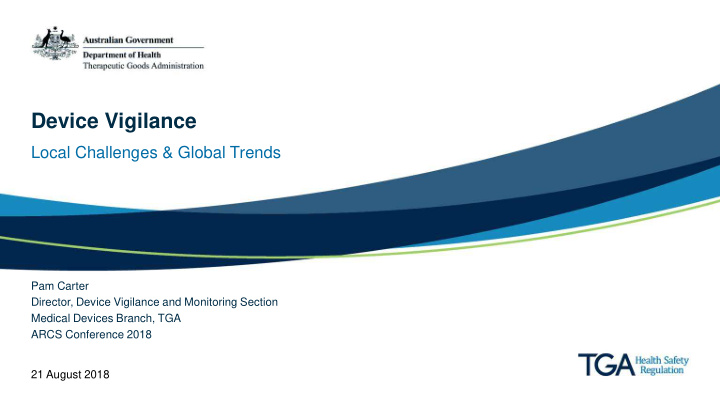



Device Vigilance Local Challenges & Global Trends Pam Carter Director, Device Vigilance and Monitoring Section Medical Devices Branch, TGA ARCS Conference 2018 21 August 2018
Topics Global hot topics and trends Local challenges • Women’s health • Medical Device reforms • Post market surveillance – MMDR – PSUR/Annual reporting – Inquiries and the results – Life cycle responsibilities • Relationship between sponsor and – Post market surveillance studies manufacturer • Reporting AEs • Education and training – Electronic – Web forms • Reporting of AEs – Databases • Relationship with health facilities and – Harmonisation professionals – Communication between regulators 1
Local Challenges 2
Expert Panel Review (MMDR) • Two reports released during 2015 – Medicines and Devices – Complementary medicines and Advertising • Review included discussion papers, submissions and interviews, followed by stakeholder workshops and other meetings • Department considered feedback and advised Minister, who took preferred position to Cabinet • Government intent released in May 2016 budget - full response released on 15 September 2016 – Government accepted 56 of the 58 Recommendations 3
MMDR medical device projects • Key projects • Designation of conformity assessment bodies in Australia • Expedited review process for certain ‘novel’ devices • Use of approvals from comparable overseas regulators • Harmonisation with the European Union • Strengthening of post market monitoring 4
European Harmonisation MMDR recommendation: • Align with new European regulatory framework where possible • Clear rationale for Australian specific requirements EU MDR and IVD Regulations came into force on 26 May 2017 Key changes include: • Essential Principles and General Safety & • Definitions Performance Requirements • Classification • EU regulations also capture in-house IVDs • Conformity assessment procedures • Implant cards and patient leaflets 5
Medical Devices reforms Patient Implant Cards and Device Information Leaflets • From 1 December 2018, patient implant cards will begin to be supplied with new implantable medical devices (starting with urogyanecological mesh) • All permanently implantable devices are affected: – Phased approach to be fully implemented by 1 December 2021 • Addresses an information gap • Exempted products: – simple implants (dental fillings, dental braces, tooth crowns, endosseous dental implants, screws, etc.) 6
Medical Devices reforms Patient Implant Cards and Device Information Leaflets Must include the following information about the device: Cards Leaflets – Name – information identifying the device, or the kind of device – Model – the intended purpose – Batch code, lot number or serial number – information explaining how to use the device safely – Unique device identifier (if any) – other information that the manufacturer considers – Manufacturers name, address and website would be useful for patients 7
Post market monitoring • Better integration and timely analysis of available datasets • Electronic reporting of adverse events • Enhanced information-sharing with overseas regulators • Deferred: Implementation of registries for all high risk implantable device 8
Reforms vs Recommendations from Inquiries • Reforms – Quicker access to medical device technology through: Multiple pathways to inclusion Use of overseas approvals • Inquiries – Hips, breast implants, urogynaecological mesh, private health insurance, cosmetic industry, health technology More oversight of medical devices pre and post market More information for patients and health professionals Medical Device Registries 9
Relationships • Relationship between sponsor and manufacturer – Signed agreements – Flow of information – Understanding the Australian regulatory system • Relationship with health facilities and professionals – inSite – Who is reporting an adverse event and to whom – Limitations of the Therapeutic Goods Act – Expectations on sponsors and manufacturers Replacement of devices Reporting 10
Education and Training • Sponsors: – Staying included – Sponsor training day – SME – consultation • Health Professionals – inSite – Web statements – MDSU – Consultation 11
Reporting of AEs Still need to work on: • No ARTG number • Insufficient information • Statistics • Timely response to investigation Getting better • Submitting final reports • Statistics • Using web portal 12
Global hot topics and trends 13
Women’s health • Mesh • Breast implants • Contraceptive devices • Morcellators • Dermal fillers 14
Post market surveillance Clinical Evidence Report • PSUR/Annual reporting – Align with European guidance Post-market Risk vigilance assessment • Life cycle responsibilities Risk – Post market surveillance studies mitigations – MDSAP – Post market reviews 15
Reporting Adverse Events • Electronic reporting • Web forms • Databases • Harmonisation – Adverse event terminology codes Annex A: Problem terms and codes Annex B: Type of Investigation terms and codes Annex C: Investigation Findings terms and codes Annex D: Investigation Conclusion terms and codes To come: Annex E - Clinical Signs, Symptoms and Conditions, and Annex F – Health Impacts • Communication between regulators 16
Recommend
More recommend